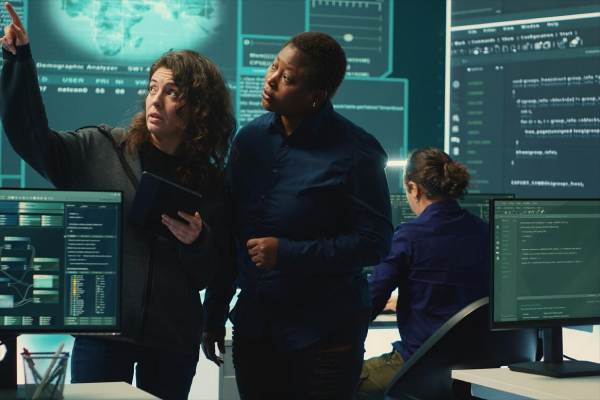In sales, a deal is often won or lost during the discovery call.
Discovery calls can be tricky. Too many salespeople ask the wrong questions, talk too much, or miss the signs that could close the deal.
But there’s a way to turn it all around.
They call it “The Pain Primer”. A framework that helps uncover what truly drives the client, setting the stage for a smooth and confident close.
Gireesh Kambala saw this problem and decided to fix it.
With over 15 years of experience in IT leadership, Gireesh has built a career solving the most critical challenges faced by enterprises and public sector organizations.
This is how they help salespeople avoid common mistakes and turn every discovery call into an opportunity to close more deals.
From Engineer to IT Strategist
Kambala’s journey to IT leadership began at the bottom of the ladder, starting out as an engineer. At IBM, TCS, Fidelity, and Collabera, Kambala didn’t just build applications—he designed enterprise-grade cloud security solutions that companies relied on. Over time, his career evolved into leadership roles, where he guided teams to successfully implement complex technologies across various industries.
By creating frameworks that ensured data security, streamlining IT operations, and reducing system downtimes, Kambala established himself as someone who could deliver both technically and strategically. But he didn’t stop there—he always focused on solutions that made life easier for the end-users, pushing IT to be more efficient, transparent and user-centered.
Bringing Change to the Public Sector
Most government IT systems lag years behind the private sector—slow, outdated, and vulnerable to security risks. But Gireesh Kambala saw an opportunity to do better. In his role as an IT leader for the public sector, he turned around numerous legacy systems that were no longer able to serve their intended purpose.

For example, in working with the General Services Administration (GSA), he overhauled their systems, moving from a patchwork of outdated software to a cutting-edge platform capable of running 40% faster and with 99.9% uptime. Federal systems that met strict security standards reduced operational costs by millions and improved day-to-day processes for government employees and citizens alike.
This approach wasn’t limited to a single agency or project. Kambala’s influence has had a lasting impact across various arms of government, where he reshaped how IT projects are handled, ensuring that innovation drives real-world change.
Teach For America’s Digital Overhaul
Nonprofits rely on digital tools to connect with communities—but slow, outdated systems make that harder than it should be. Teach For America was no different. The organization needed an update to its infrastructure that would improve the way they worked with both students and alumni.
Through his leadership, he implemented an entirely new system to help Teach For America become more efficient. This change not only ensured better internal communication but also made their platform much easier to use for alumni, recruiters, and volunteers.
Kambala also built the Alumni Directory—giving thousands of former corps members a single platform to mentor, collaborate, and share opportunities.
Georgia’s First Fully Digital eCourt System
Gireesh Kambala has worked on multiple groundbreaking projects throughout his career. One of the standout achievements was leading Georgia’s effort to become the first state in the nation to fully digitize its court system.
For years, Georgia’s legal system was trapped in a digital disaster. Judges struggled to access case files, clerks were forced to re-enter the same data multiple times, and attorneys faced constant delays in filings and hearings due to system failures. The court’s outdated technology wasn’t just inconvenient—it was actively obstructing justice.
The project was complicated, involving a broad range of technologies and requirements from across the state government. The failure wasn’t just technical—it was a misunderstanding of how courts actually work. Vendors built software that looked good on paper but fell apart in real-world use by judges and clerks.The situation had reached a breaking point.

That’s when Gireesh Kambala took over the challenge that others had failed to solve. Instead of forcing a generic software solution onto the courts, he immersed himself in understanding the actual needs of judges, attorneys, and clerks. His approach was different—he listened before he built.
Working closely with Georgia’s legal teams, Kambala and his team designed a completely new digital court system from the ground up—one that didn’t just replace the old system but fundamentally improved how courts operated. The platform enabled secure online filings, instant case access, automated data entry, and remote hearings, all within an efficient, intuitive interface built for real-world use.
The impact was immediate. Within months, Georgia’s fully digital eCourt system was operational statewide, eliminating backlogs, saving millions in operational costs, and setting a new standard for digital transformation in the judicial system.
Where others had failed, Kambala succeeded—not just by fixing technology, but by fixing how technology worked for the courts.
Mentorship & Industry Influence
But Gireesh’s work doesn’t stop with technology implementation. He’s also committed to shaping the next generation of IT leaders. His mentorship programs have helped hundreds of IT professionals move into leadership roles, many within just three years. By emphasizing a practical, hands-on approach to IT leadership, Kambala ensures that the leaders he mentors aren’t just proficient in technology—they’re also capable of transforming their organizations and their communities.
In fact, his influence stretches far beyond the workplace. He is frequently invited to speak at industry events, where he shares his insights into the future of IT, cybersecurity, and cloud technologies. He doesn’t just talk about theory; he shows how IT can be applied to create real, lasting value.
Kambala’s Next Big Move: AI, Cybersecurity, and Leadership
After decades of revolutionizing IT across different industries, Gireesh Kambala is now focusing on what’s next in the world of technology. AI, cybersecurity, and leadership are where he sees the future. With the rise of new technologies, Kambala is focused on building systems that can scale not just for today but for tomorrow—systems that are designed to adapt and evolve with emerging trends. And he’s working on the frontlines of securing those systems to ensure they remain protected from evolving threats.

His next big move is about blending these technologies into a cohesive strategy that will provide long-term solutions, not just short-term fixes. He believes that building systems for the future requires both a deep understanding of the technology and a clear vision of how it impacts the real world.
Final Thoughts
Gireesh Kambala’s legacy? Systems that work, leaders who lead, and a technology landscape that’s stronger because of his vision.
He’s not just building software or managing projects—he’s shaping the future of IT, helping organizations evolve into forces that can adapt, grow, and lead.
His work continues to change the way we think about technology, pushing boundaries and setting new standards for what’s possible in the enterprise and public sectors alike.

